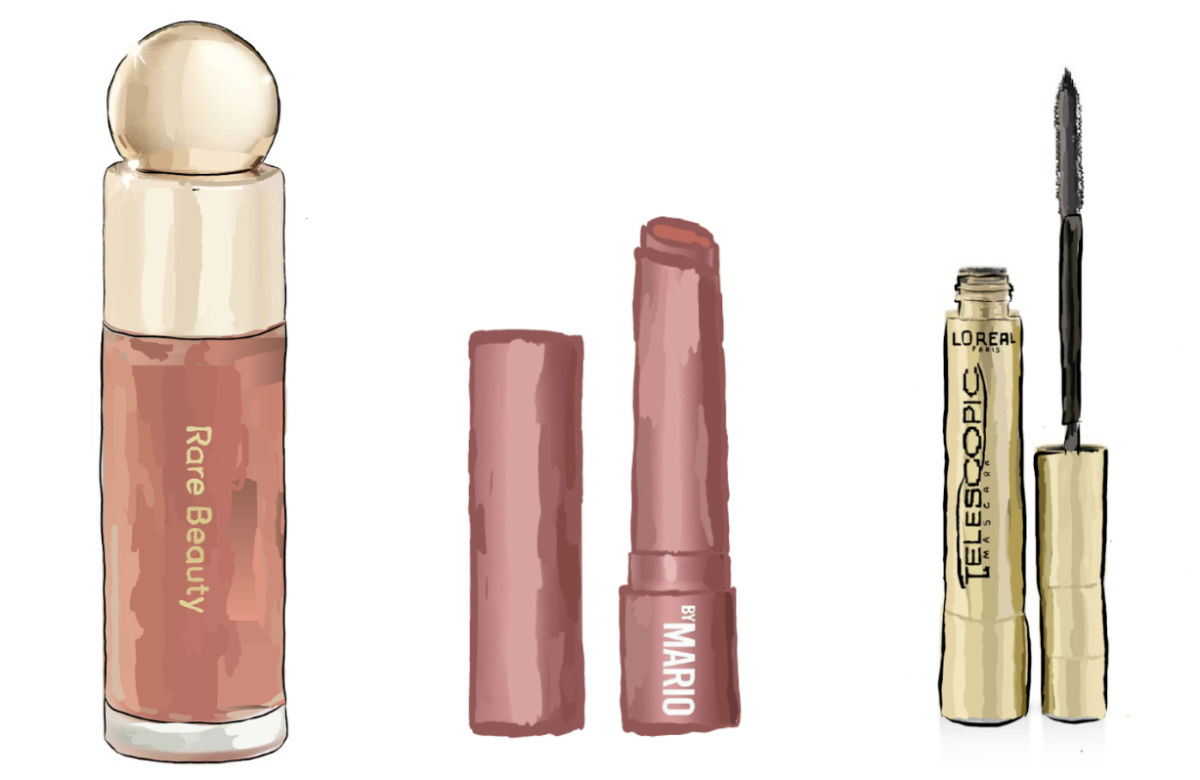Erica Rawald (’14) began spending time in the ceramics classroom because her sister Nicole (’11) was an Advanced Placement (AP) art student.
Fidgeting and playing around with clay for the first time, Rawald decided to begin her own sculpture. Her final product? A small glasses-wearing frog on a lilypad.
Three years later, the glass display case in the art room is littered with her pieces from over the years, each recognizable by the painstaking precision she puts into every detail.
Now Rawald is completing her own AP Studio Art: 3–D Design Portfolio, comprised of photographs of pieces in three sections: Breadth, concentration, and quality. The portfolio must consist of a minimum of 11 pieces completed over years of work in the ceramics room.
Rawald began taking 3-D Studio Art during her sophomore year, and said, “It kind of just stuck, and I’ve loved it ever since.”
There are two main forms of 3–D Studio Art: Sculpting and throwing on the wheel. “Other art students might focus on the wheel, and they have some incredible work, but me, I mainly focus on sculpting,” she said. Rawald admitted, “I’ve tried the wheel and it’s not the prettiest sight.”
The level of control one has when sculpting is part of why this technique appeals so much to Rawald. “I know exactly what I want, I always have a clear vision in my head, and it’s so easy to execute in clay,” she said. “I feel like I’m in control: I do what feels right, and it has worked out pretty well so far.”
Two of Rawald’s concentration pieces already sit behind the glass barrier of the ceramics room display. They reflect the evolving tone of her work. Next to Rawald’s oldest piece, the ocularly challenged frog, a grinning skull and sinister beetle carry a tone that is admittedly darker than before, and Rawald concedes to that growth. “[The frog on the lilypad] was just a weird and silly thing that I did, but now if you look at the things I’m making they’re drastically different.”
Rawald’s concentration is based on the culture and art of steampunk, a form of science fiction which features steam-powered machinery. Through her artwork, she explores the clash between very organic materials and the mechanical, industrial themes. Visual Arts Teacher David Pritchard believes that her collection is dynamic. “It’s contemporary theme that has loose borders, loose parameters; it has a general look to it but is still very open. I don’t think anyone else has narrowed down their concentration so much yet,” he said.
Rawald’s first piece of her concentration, a beetle whose insides are filled with gears and intertwined mechanics, embodies that clash. Rawald went through her usual process to create the beetle: First sculpting, then bisque firing – the first firing in the kiln – then glazing, then firing once again to finish. After the process was completed, she placed her specially-ordered gears inside the sculpture and fitted a window into a hole on the shell.
Her second piece has “the same sort of idea, where it has a window into the skull with mechanical pieces, mixing organic and industrial themes.” The challenge with this one was not fitting the gear systems, but instead molding the shape of a human skull into the pliable clay. “It was great because [Visual Arts Teacher Martin Drexler] has these skulls he uses in his Drawing and Painting Classes, so he let me borrow a skull and I worked with that skull every day,” she said. “It was a tricky piece,” Rawald admits, “The jawline especially, because it’s connected to the skull but there are also pieces that aren’t, and grooves in the bone. I really had to take the time to study the skull as much as possible.”
The idea for her third piece came from one of her many conversations with Pritchard. The piece, which had yet to be fired when we met, was carefully wrapped in sheets of plastic to hold in moisture and prevent drying. Underneath layers upon layers of plastic, Rawald uncovered her work in progress, a bulky Victorian-style lock wrapped in octopus legs. A closer look into the piece, and one finds it looking back at you: A scaly eye peeks out from the keyhole of the lock.
Rawald’s time-frames for her pieces often overlap, as they do now. As she waits on the industrial pieces ordered for her third piece, Rawald has already begun a fourth. It’s unrecognizable at this point, she said, but she mentions the stares she received while completing research for the piece. “I was looking at steampunk art for inspiration and I came across a gas mask, so I started looking into them and there were some that had animalistic features to them,” she said. “I thought it was really cool, so I’m doing my own variation.”
Rawald has chosen to mix the features of a pig’s head with the hardness of a gas mask. “I wanted it to be anatomically correct, to be recognizable, so I searched Google for images of pig heads. I came across a lot of disturbing images, needless to say.”
As Rawald continues with her AP 3-D Studio Art course, her biggest challenge is an internal one. “I’m very critical of my own art,” she said. “Whenever something comes out, even if people are telling me it’s really good… I’m always thinking, ‘I wish I had done this…’”
Pritchard sees her obsession with detail and perfectionism as both a blessing and a curse. “Her absolute obsession with detail, that’s what sets her apart. She’s really into pushing it and getting the level of detail that goes above and beyond, raising her bar a little higher everytime,” he said. “But you can get into a trap because you constantly want to outdo yourself.”
First, Aaron Kelly-Penso (’14) puts down an imprimatura on a previously white canvas: “The imprimatura takes the whiteness out of the canvas because very few things in nature are naturally, completely white.” After he puts down the imprimatura, Kelly-Penso will make a box for the subject of his painting, which allows him to balance the proportions of the image early in the process, “as Mr. Drexler will stress many times.”
From there, Kelly-Penso slowly chips away at his image “almost in a sculpture kind of way,” to slowly get the shape, mark out the shaded areas and continue to refine his piece. Then the ever-in-motion Kelly-Penso digs out a new painting, sidelining the old painting for up to a month until he feels he can get enough perspective to do the final finishing touches to the canvas.
After three years of working in Drexler’s classes within the art department, it takes Kelly-Penso approximately two weeks to come close to a finishing point on a painting, at which time he chooses to take a break for up to a month. “There comes a point in any piece where you just absolutely hate it and you just have to take a couple of steps back, work on something else maybe,” he said. “Otherwise you’ll get so nitpicky with your own work that you’ll be going in circles.”
Or sometimes, more simply, Kelly-Penso will get bored of the piece he has pored over for so long and “not want to look at it for a while.”
Kelly-Penso is now taking part in the AP Studio Art: Drawing course at ASL, which requires him to submit a portfolio in May which coincides with the exam weeks for all other AP exams. Similar to the 3-D and 2-D Design portfolios, Kelly-Penso’s final portfolio must be comprised of three sections: Concentration, breadth and quality.
Kelly-Penso is currently working on completing his 12 pieces for his concentration portfolio, a single portfolio built on a common theme, while his breadth and quality pieces have accumulated over his years of work in the art wing.
“The breadth pieces have been things that we’ve been doing since, if we’ve been good enough, our freshman and sophomore years. For most of us it’s pieces that we made during our junior year,” Kelly-Penso said.
The AP Studio Art students have been refining their skills for between three and four years and have several paintings from in-class assignments: Paintings of bottles and pots and pears and more. “They’re supposed to show how well you can apply the paint, how well you can portray what you’re trying to portray and really the quality of the painting,” Kelly-Penso said.
In order to finish a total of 12 concentration pieces before the AP portfolio deadline, Drexler tasked the students with finishing between five and seven pieces in the first semester. Kelly-Penso originally found it to be a challenge to balance college applications and a senior workload, but “I realized that I could lighten up the time that I came in outside of class and just work really hard during class. I figured that I would be able to handle that,” he said.
Kelly-Penso’s concentration is about his Turkish family. “We were picking our concentrations in the summer of last year and that was during a time of political instability in Turkey,” he said. “I wanted to go off of that as well.” Kelly-Penso works mostly from old photographs of distant relatives whom he has never met. He has a series of portraits of these family members completed already.
Since he had never painted portraits before, Kelly-Penso found his first few pieces a challenge. “Since I was painting from old pictures, it was tough to get some of the details,” he said. “Then I realized, fairly quickly, that it didn’t have to be exactly what I saw on the picture. I could kind of make stuff up.”
Through explaining the creation of a portrait of his great grandmother Estrella, Kelly-Penso explained his process.
“I started out by just putting color on canvas, seeing what happened.” Like many of his pieces, when he began, he had no idea what the final product might look like. “I didn’t like it at first, so I brushed it all back, and I started dolloping color on it just to see what would happen,” he explained. The Turkish Hand of Fatima has become a recurring motif in his work, a symbol that he noticed a lot growing up in connection to his Turkish heritage, “It’s one of my earlier links to my Turkish family.”
Kelly-Penso is most proud of the portrait of his mother he created earlier this year, one of his first concentration pieces. The painting is also inspired by a photograph: This one of his mother in a primary school play in Turkey. “She looks exactly the same, and I kind of like that,” he said. “I liked this one because I can really see that this looks like my mom. It’s a very satisfying feeling to know that I successfully achieved what I wanted: To portray what my mother looked like.”
Currently, Kelly-Penso is working on yet another oil painting, a portrait of two relatives: “I can’t quite remember the relation; there are several greats and then grandparents.” He has an idea of what the painting will turn into, perhaps two scraps of paper with the two portraits on them sitting around on a table of some sort, but admits that sometimes his ideas change. “With some pieces I am constantly changing my ideas, and with others I tend to stick with a single idea,” he said.
Drexler has great hopes for Kelly-Penso’s future, regardless of whether he decides to focus on art. “The one thing I’ve really enjoyed about working with Aaron over the years is that he’s truly an individual, and not at all afraid to be himself,” he said. “As an art teacher, you can’t ask for more than that: For someone to come in and feel comfortable in their own skin.”
svena_bhasin@asl.org



